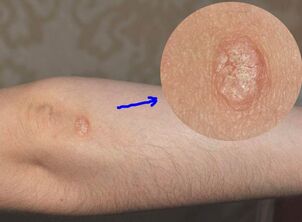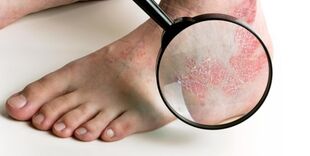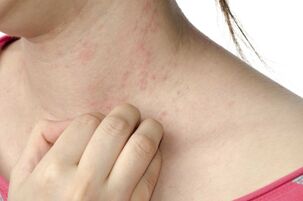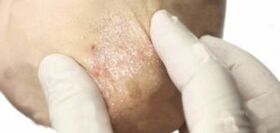Psoriasis is an inflammatory skin disease. Occurs when the immune system malfunctions. The development of the disease is divided into clear stages - emergence, progression, stabilization and regression. The different stages of psoriasis differ in the appearance of spots and rashes, itching and widespread dermatitis.
Why is it necessary to differentiate the stages of disease development, which manifestations of psoriasis at the onset of development and in the process of recovery?
Why you need to know the stages of psoriasis

The division of psoriasis into stages is used by doctors to select the correct treatment. The complex of drugs and external agents that are indicated for the treatment of inflammation depends on the stage of the disease's development. At the beginning of the manifestation of the disease, general treatment is required - multivitamins, diet, aseptic external treatment for the rash, for example, a UV procedure process. Also prescribed drugs that stimulate cleansing of the intestines, blood vessels, liver. Be sure to perform an adjustment of the psychological state - by a neuroscientist or psychologist.
In the early stages of the disease, they do not use strong drugs that can suppress the immune system, do not prescribe hormonal ointments. These medications have a large list of side effects, so they are prescribed only when it is impossible to take without them.
Psoriasis: treatment in the acute phase and remission
In the case of an acute progressive disease, several drugs are prescribed. Immunosuppressants and glucocorticosteroids are often used to reduce inflammation and itching. External treatments are complemented by photochemistry, ultrasound and laser therapy. In addition, substances are prescribed for antiseptic treatment of damaged skin.
In steady state, they continued to take anti-inflammatory hormonal drugs, gradually reducing the dosage. For the restoration of damaged skin, an ointment with a regenerating effect is prescribed.
Remission - support of the body. Proper nutrition, take vitamin and mineral complexes to restore immunity.
Prompt treatment
The earlier you start treatment, the easier it is to control psoriasis. Prompt treatment limits the spread of dermatitis, reduces its level and prevents subsequent flaking recurrences. Since psoriasis is often mistaken for an early allergic rash, it is important to know its early signs so as not to miss the manifestation of a skin disease.
Note: Doctors are still investigating the cause of psoriasis. But everyone knows that psoriatic dermatitis is not contagious. It cannot be picked up from the sick person, or infected in the event of an injury. This is our own failure, the individual in the human body.
Psoriasis is caused by an immunodeficiency, which can be caused by a variety of factors. Severe stress, poisoning (including strong drugs, industrial emissions, alcohol), previous infection.
Psoriasis is very difficult to treat. The disease is easy to recur, recurrence. And therapy itself is the symptom. It includes preventing the appearance of new spots and relieving existing skin itching.

What stage of psoriasis is called initial? How to distinguish early psoriasis from a visceral rash? And how will the disease develop in the future?
Psoriasis: early stage
The first appearance of psoriasis on the skin looks like a pimple. Usually, the rash appears at the bends of the elbows and knees, or where the clothing is pressed tightly against the body (for example, below the waist at the waist). The rash can also appear along the hairline and under the hair, around the nails, and on nail plates. Psoriasis sometimes occurs on the feet and palms.
Psoriasis Almost always manifests itself symmetrically - on the elbows of both hands, or on both sides of the lower back or above the knees. The boil itself (in medical terms - papules) in the early stages has a humble appearance. They have:
- Pink or red;
- Sharp, matte edges;
- Small size - acne at the base of no more than 2 mm;
- Flat - the small pimples early in the disease have almost no blister, so they look like pimples.
As the disease progresses, flaky patches of skin appear on the pimples. They are gray or silver in color, on a red background they appear white.
Scaly appearance accompanied by intense itching. If you do not resist and scratch, the scabs will peel off, revealing areas of shiny young skin underneath. It is very thin, very vulnerable, when prolonged scratching will itchy pimples - it hurts, bleeds.
The initial stage of psoriasis lasts up to 4 weeks.
Psoriasis: advanced stage
During the progression, individual bumps fuse into a common spot, forming what is called a psoriatic plaque. They stick to the surface of the skin and are almost completely flaky. At the edge of the psoriatic plaques there is a non-flaky, pink-red rim.
The presence of the earcup is a sign of a progressive stage of the disease. Rim width is 1-2 mm. The skin on it is inflamed and resembles parchment in structure.
The rim represents the enlarged area of the point. This is an area of skin that is inflamed, but not flaky. After a while, it will also become scaly. And the patch will expand to cover new areas of skin and form a new, wider rim.
With the active development of the disease, the adjacent spots fuse together. At some point, a large, inflamed red spot may form on the human body.
Very itchy patches of psoriasis cause discomfort for the patient, disrupting work, rest and sleep. They grow, occupy a large area and form a new rash on clean, healthy skin.
The main sign of progression is the appearance of new rash. As soon as the pimples and pimples stop appearing, the next stage of psoriasis begins - stillness. This is not yet a complete victory, but it is already a step toward recovery.

In the progressive stage, psoriasis is almost always accompanied by depression, fatigue, and weakness. Depression is common. Possible temperature.
The advanced stage of psoriasis can last up to several months.
Psoriasis: a stationary phase
The main sign of a sedentary phase is the cessation of the appearance of new spots and rashes. At the same time, the itchiness is also reduced and more comfortable. The rash is bright discolored, discolored, not visible. This is also one of the signs that the movement is stabilizing.
The pink borders around the plaques disappear once the inflammation stops spreading. Activates exfoliation and healing activities, and renews healthy skin.
It can be seen with the naked eye that peeling increases during the stationary phase. The scales completely cover the entire surface of the psoriasis, leaving no space for the rim. The characteristic flaky psoriasis is often recognized by the public.
Large flaking at the stationary stage is not dangerous. When all the dead cells slough off the surface of the psoriasis, healthy skin with light shine will remain in their correct place.
Other signs of progression or stability
In addition to the appearance of hives, spots and scabs, there are a number of other signs that can be used to judge the development of the disease. This is the nature of the itchy sensations (strong or tolerable), the general condition, the depressed mood. And temperature is present.
In the early stages, the itching may change and the rash cannot be understood. What's more, the itch gets worse every day. During the acute course of psoriasis, it becomes intolerable. Interrupting sleep, resting, interfering with work. The person becomes irritable because the itchy sensation does not give him a chance to rest.
During a sedentary phase, the itching subside. Every day - one person feels better. The general state of psychology changes, negative moods and depression weaken. The duration of the static phase is several weeks - from 2 to 5.
Psoriasis in a descending stage
The fading stage of psoriasis is the almost complete disappearance of plaques, spots, redness, inflammation, itching. At this stage of the disease, only different pigmentation is reminiscent of psoriasis. Instead of the previous psoriasis, it looks lighter. The surface of healthy skin has a darker color.

In some cases, so-called hyperpigmentation is formed. The skin at the site of the psoriasis does not become brighter, but it is also darker. In any case, the difference in skin pigmentation should be visible within one to two months.
Psoriasis after recovery: recurrence
The likelihood of psoriasis recurrence is determined by lifestyle, diet, allergic mood, and general state of the body. It is also determined by the amount of toxins in his body, blood, and liver. You can minimize the likelihood of recurrent dermatitis if you strengthen your immune system and clear your body from toxins in the liver, blood vessels, and intestines.
Seasonal recurrences of psoriasis are usually rare after cleansing. A person is still susceptible to getting sick, but the likelihood of it happening is greatly reduced.
Purifies the body to detoxify and replenishes complex vitamins and minerals to boost immunity. This is especially important if immunosuppressants are used during treatment, during the advanced phase of psoriasis. Their need is due to the work of inflammatory mediators. After suppressing autoimmune defenses, it is necessary to restore the immune system.
Clinical manifestations
Psoriasis is characterized by monomorphic outbreaks in the form of papules (erythema) of various sizes, when they join together to form plaques that can spread throughout the skin.
When onset, in most cases, the rash is limited to and manifested as single plaques in its preferred locations (scalp, elbow extensor surfaces, knee joints, sacral region, etc. ).
Clearly demarcated plaques with healthy skin, bright pink or deep red, covered with loose silvery-white scales, when scraped you can get a phenomenal trio of characteristicpsoriasis - "stearin spot", "terminal membrane", "blood mist". . .
There are three clinical stages of psoriasis: progressive, stopping, and regressing.
Category
Depending on the severity of the inflammatory process, the primary site of the rash, the severity of the patient's condition and other clinical signs, most commonly plaque psoriasis, exudate, scalyarthritis, pustules, erythematous psoriasis, psoriasis, psoriasis of the palms of the hands and soles of the feet. It should be noted that different clinical variations may co-exist in one patient at the same time.
Exudative psoriasis is characterized by a pronounced inflammatory skin reaction, manifested by the presence of lamellar scaly layers on the surface of the plaques, sometimes laminated, which look like a cakebulging (in such cases, this form of psoriasis is called psoriasis). When the scales are removed, a crying surface is revealed.
Joint psoriasis on clinical picture, in addition to normal erythematous plaques, joint lesions, often small, distal, less often large.
Joint disease can happen with or before skin damage. Psoriatic arthritis is manifested by pain, swelling, and mobility restriction in the damaged joints of many different degrees, from the small joints of each joint to the systemic lesions and disability of the patient. The likelihood of developing joint psoriasis is higher in patients with severe skin manifestations (erythematous psoriasis, purulent psoriasis), but severe joint damage can be associated with a relatively limited skin rash.
Pus can be systemic (Tsumbusha) and limited, with the involvement of the palms and soles of the feet (Barbera). Stressful situations, infections, general or inadequate local therapy contribute to this severe form of psoriasis.
Systemic pustular psoriasis occurs with fever, leukocytosis, increased ESR and a serious general condition. Suddenly, on a bright erythematous background, small superficial pustules appear, accompanied by a burning sensation, they can be in the area of normal plaques and on the previously unchanged skin area. New pustules appear paroxysmal, occupying a large area of the skin. The fused pustules cause the epidermis to flake off in the form of a "purulent", red blood cells can develop.
Confined pustular psoriasis is more common, the rash is mainly localized on the palms and soles of the feet as pustules against a background of erythema and infiltrates. Progression, compared with generalization, is milder, with a stable, but persistent, recurrent general condition. A local irritant therapy is a trigger.
Scarlet psoriasis is a severe form of psoriasis, which develops with a gradual progression of the psoriasis process and a combination of plaque components to loss of entire skin, characterized by pulseshemoglobin, edema, skin infiltration with large and small plates, less frequent desquamation. Subjective - severe itching is often noted. It can start with scarlet fever. The general condition worsens (fever, weakness, lymph node reaction, heart failure, impaired liver and kidney function, changes in blood tests, hair loss, etc. ).
Pleated psoriasis is common in children and the elderly, especially in diabetics. Lesions are localized in the armpits, below the mammary glands, the epithelium, the groin-thigh folds, in the navel and have a clear border, saturated red color, mild peeling.
Psoriasis on the palms of the hands and soles of the feet can exist alone or simultaneously with damage to other skin areas; The characteristic trio of psoriasis is very difficult to evoke.
Three clinical stages of psoriasis
Progressive stage. Under the influence of provoking factors (trauma, psychological - emotional stress, infectious disease, inappropriate treatments, etc. ), exacerbations of the disease can develop with the appearance of multipleSmall nodules are easy to develop on the periphery and form plaques of varying sizes and shapes, which can be isolated or occupy a large area of the skin up to universal skin lesions.
During the progressive phase, a symptom of isosceles reaction (the Kebner phenomenon) is characteristic, characterized by the fact that typical psoriasis episodes appear at the seismic site. injury, even a small wound.
Stationary stage. In the stationary phase, the emergence of new elements ceases and the trend of peripheral development disappears.
The recession phase. The degenerative stage is characterized by a decrease in the color intensity of the plaques, their flattening, reduced flaking, infiltration, reabsorption of elements with the subsequent formation of reduced or hyperpigmented nocturia. previous rash location.
Treatment
Treatment of psoriasis is aimed at suppressing the proliferation of epithelial cells and eliminating the inflammatory process and is prescribed taking into account the pathological data, form, stage, prevalence ofcourse, comorbidities, age and sex of the patient, contraindicated to a certain method of treatment or drugs.
For mild, restrictive psoriasis manifestations, local external therapy in the form of salicylic ointment, naphthalan ointment, tar ointment or emollient is sufficient. Severe forms of the disease require complex systemic treatment with the use of antidotes, desensitizers, anti-inflammatory drugs of different groups, physical therapy methods, topical drugs, etc. v.
This section will present the most modern and effective methods and means of treating psoriasis.
Body therapy
There are characteristics of the management of patients at different stages of the psoriasis process. Treatment of the severe stage requires special care. During this time, hemodez is prescribed intravenous drip, 30%. sodium thiosulfate i / v solution, 10% calcium gluconate solution, with simultaneous hypertension, should recommend a solution of magnesium sulfate; emollient or 1-2 percent cream is used externally. salicylic ointment.
Aromatic retinoids.Acitretin (neotigazone) - a representative of the second generation of monochromatic retinoids used to treat severe forms of psoriasis at a dose of 10 to 20-30 mg per day, depending on the levelseverity of skin processes. The mechanism of action of acitretin is to inhibit the proliferation of epidermal cells, normalize keratinization processes. It is particularly effective in combination with PUVA therapy. When prescribing acitretin, one should not forget its teratogenic effects.
cytostatics.Methotrexate is used in the case of persistent psoriasis and has contraindications to other treatments, as a folic acid antagonist, it works mainly on active proliferating cells. Very toxic. There are many methods of application, preferably intramuscularly once a week under the strict control of the laboratory.
Immunosuppressants.Cyclosporin-A is prescribed for severe widespread psoriasis that is resistant to other therapies. This drug has an immunosuppressive effect, has an inhibitory effect on cell growth, suppresses the secretion of activated lymphocytes of cytokines and the expression of receptors to interleukin-1 above. immune cells. In psoriasis, it is prescribed at the rate of 5 mg per 1 kg of body weight per day.
Nonsteroidal anti-inflammatory drugsare prescribed for arthritis psoriasis, as well as for the reduction of acute inflammation in exudative psoriasis and dermatitis. The daily dose of the drug and the duration of treatment depend on the intensity of the pain syndrome, the degree of inflammation and the individual tolerance.
The use of systemic corticosteroid drugs in the treatment of psoriasis is considered inappropriate, it leads to the development of torpid forms of the disease resistant to different types of therapy. In the case of severe joint psoriasis, prolonged endoscopic corticosteroids can be used, and the dosage and duration of treatment depend on the size of the affected joint and the degree of inflammation.
Physiotherapy treatments.One of the most effective treatments is PUVA or photochemical therapy (PCT). PCT is a combination of long-wave ultraviolet radiation (wavelengths between 320 and 420 nm) and photosensitive furocoumarin. The use of photosensitizers is due to their ability to increase the skin's sensitivity to ultraviolet rays and stimulate the formation of melanin pigments. PUVA therapy leads to inhibition of cell proliferation, inhibition of pathological keratinization, affects the metabolism of prostaglandins, and membrane permeability. The peak of photosensitivity effect occurs 1-3 hours after oral administration of 8-methoxypsoralen. The dosage of the drug is chosen taking into account the weight of the patient. The therapies are carried out 3-4 times a week, in a course of 20-25 sessions.
local PCT is also used using external photosensitive.
The use of a combination of PUVA and retinoids therapy is known as Re-PUVA therapy. It is most clinically effective in severe cases of psoriasis.
Selective phototherapy (SFT) - irradiates ultraviolet light in a medium wave spectrum (wavelength 280-320 nm) without the use of photosensitive. SFT is used for less obvious manifestations of the disease, the presence of contraindications to the indications of PUVA therapy.
How to recognize psoriasis in the early stage
The most effective treatment of psoriasis is at its earliest stage. Therefore, a timely diagnosis is very important. Only a dermatologist can tell you if you have psoriasis or some other skin condition. However, you can personally recognize this disease in you by some characteristic signs:
- Usually, psoriasis first manifests itself on the folds of the arms and legs, on the roots of the hair, or where the clothing comes in close contact with the body or rubs it - under the waistband, the elastic bandor straps are different.
- When onset, a severe itch develops, covered with gray or silver scales, which is easy to remove.
- Removing scabs will reveal thin, shiny, and slightly moist skin.
- If you scrape off the plaque with something like a spoon, removing the scabs, blood will appear on the stain as droplets. However, it is better not to use the following method to identify psoriasis yourself - very susceptible to infection.
To be completely confident, you need to see a doctor, as patients themselves often confuse psoriasis with lichen or atopic dermatitis and use inappropriate drugs for treatment.
What to do if you notice symptoms of early stage psoriasis?
Psoriasis cannot be cured once and for all, so the main goal of therapy is to achieve maximum stable and lasting remission. You should know that without proper treatment, psoriasis quickly becomes chronic: exacerbations can occur up to 9 times a year, with durations lasting up to 15 days.
What to do if you suspect you have psoriasis? Usually, people, upon discovering signs of the disease in themselves, make a big mistake of using a "heavy cannon" - a hormonal ointment (called topical glucocorticosteroid, or lower secondary) without consulting a doctor. Usually, patients explain each step like this that they are supposed to have heard from friends that such funds will help quickly. This is a big mistake!
Is there any danger of self-medication? Hormonal ointments for psoriasis have a lot of side effects and contraindications. It is highly undesirable to use them without a doctor's strict recommendations regarding duration of use, frequency, area of use on the body nor taking into account the individual characteristics of your body.
Non-hormonal agents such as zinc pyrithione should be used for the effective treatment of early stage psoriasis. Pyrithione zinc, or active zinc, is a very effective remedy for the treatment of psoriasis, with a complex effect:
- suppresses the proliferation and inflammation of excess skin cells, reduces the formation of psoriatic plaques and psoriasis;
- relieves itching;
- protects damaged skin from bacterial and fungal infections;
- restores the lipid layer and protective functions of the skin.

























